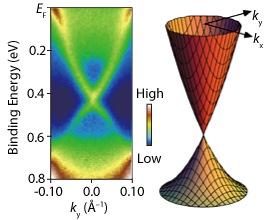

12/27/2010

© 2010 APS
Spintronics is a promising alternative to conventional electronics: the use of an electron’s spin instead of its electrical charge offers a relatively easy and energy-efficient way of manipulating information. Unfortunately, these spins don’t travel very far without the information they carry being destroyed. A new class of materials known as topological insulators could offer a solution to this problem by allowing almost unhindered spin transport, but owing to fabrication and materials issues, none of the topological insulators known so far have clearly demonstrated this ability. Researchers from the WPI-AIMR and the Department of Physics at Tohoku University, in collaboration with colleagues from Osaka University, have now discovered a material that could alleviate such problems1.
As their name suggests, topological insulators have to be electrically insulating — that is, have an energy gap in their electronic states that electrons cannot overcome. Their unique properties arise on the surface, where they are electrically conducting. These conducting surface states are topologically protected, which means that electron spins are protected from degradation by, for example, the presence of impurities in the material.
So far, only a limited number of topological insulators have been discovered, among them Bi2Se3. The problem with virtually all of the existing compounds is that their energy gap is too small, and so they are in fact electrically conducting in the bulk. The researchers have now discovered a new topological insulator, TlBiSe2. They found that the use of thallium considerably widens the band gap, leading to a topological insulator with the largest known energy gap. The existence of protected surface states was confirmed by the tell-tale crossing of surface electronic states (Fig. 1). “The enhanced material properties of this compound strengthen the foundation for high-speed, low-power consumption devices powered by topological insulators,” says Seigo Souma from the research team.
Like most other topological insulators, the samples fabricated from this compound are still electrically conducting throughout. According to Souma, this most likely results from mismatches in sample composition, and could potentially be solved by tuning the ratio of thallium and bismuth in the samples. The quality of the samples prepared is sufficient to allow the precise investigation of their properties using the ultrahigh-resolution angle resolved photoemission spectrometer (ARPES) installed at Tohoku University. In any case, the insight gained in this study will also aid the search for new, related topological insulators, says Souma. “The discovery of a topological insulator in this TlBiSe2 ternary compound indicates considerable potential for the discovery of further topological insulators.”
Sato, T., Segawa, K., Guo, H., Sugawara, K., Souma, S., Takahashi, T. & Ando, Y. Direct evidence for the Dirac-Cone topological surface states in the ternary chalcogenide TlBiSe2. Physical Review Letters 105, 136802 (2010). | article
This research highlight has been approved by the authors of the original article and all information and data contained within has been provided by said authors.